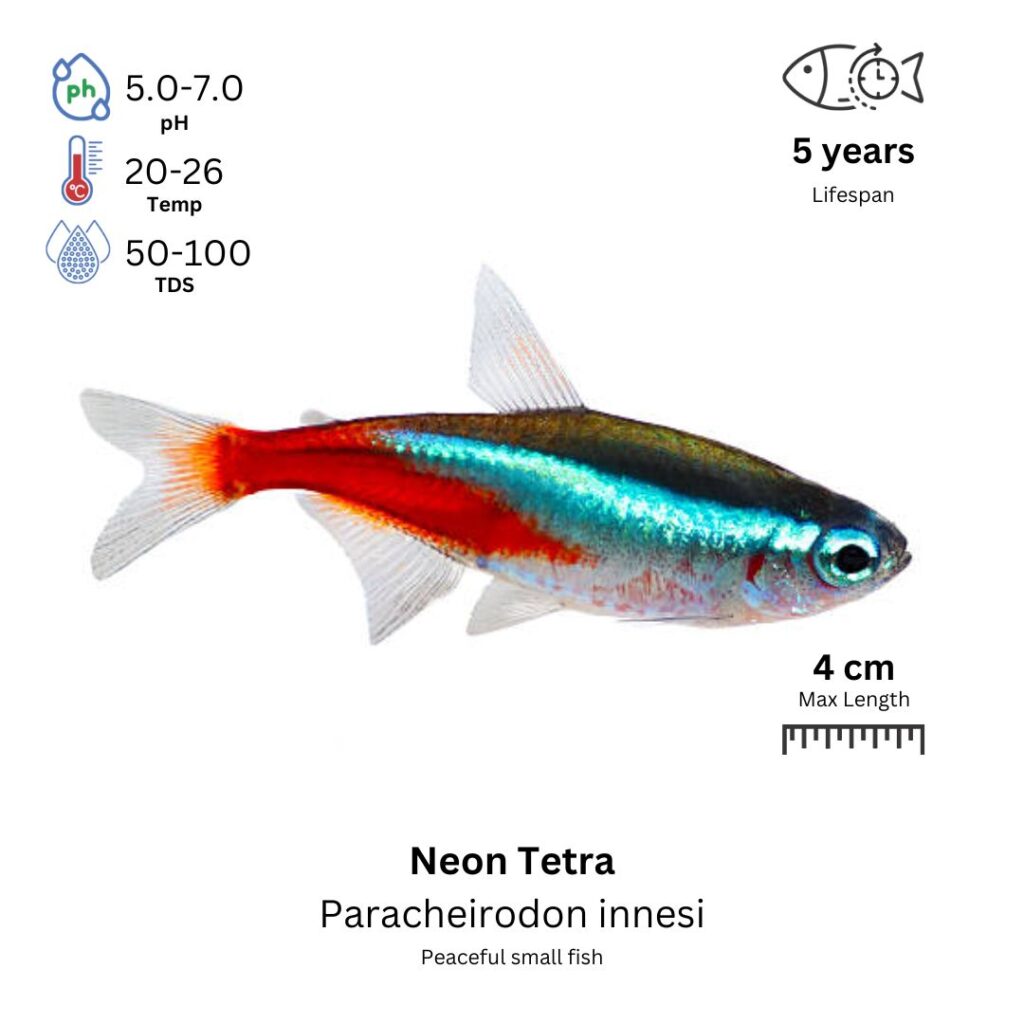Neon Tetra
Paracheirodon innesi

Description
Neon Tetras are small, brightly colored fish known for their vibrant blue bodies and red underbelly. The blue strip runs from their head to their tail, while the red stripe typically extends from the middle of their body to their tail. They are very peaceful, active fish, often found swimming in schools. Neon Tetras are incredibly popular in aquariums due to their bright colors and their gentle, sociable nature. They usually inhabit the middle regions of the aquarium and thrive in groups.
Natural Habitat
Neon Tetras are native to the Amazon River basin in South America, specifically in Colombia, Brazil, and Peru. They live in slow-moving, slightly acidic waters with low to no current, surrounded by dense aquatic vegetation. The water in their natural habitat is soft and slightly stained due to the abundance of organic matter.
Aquarium
Ideal Group Size: 6-10 fish (schooling)
Favorite Foods

Neon Tetras are omnivores and will eat a variety of foods, including flake food, fish pellets, and live foods such as brine shrimp, bloodworms, and mosquito larvae. They also enjoy eating vegetables like cucumber, spinach, and other plant matter.
Behavior:
Neon Tetras are peaceful and social. They prefer to live in schools and are constantly swimming and foraging for food. They are not territorial or aggressive, making them great for community tanks. They are most active in groups and offer a dynamic and colorful display in aquariums.
Special Care:
Neon Tetras require aquariums with good filtration and stable water quality. They are very sensitive to changes in water parameters, so it is crucial to maintain clean water with consistent temperature and pH. They thrive in tanks with live plants and gentle filtration to mimic their natural environment.
Compatibility with Other Fish:
Yes, Neon Tetras are compatible with other peaceful fish such as guppies, rasboras, corydoras, and other small, non-aggressive species. They should not be kept with larger or aggressive fish that may harass or eat them.
Breeding Tank Setup
A separate breeding tank is highly recommended when breeding neon tetras to maintain a controlled environment and prevent adults from eating their own eggs. A 20-gallon (around 75 liters) tank is sufficient for a pair, while larger setups of 30 gallons (115 liters) or more are ideal for multiple pairs. The ideal water conditions include a pH between 6.0 and 7.0, a temperature range of 22°C to 28°C, and soft to slightly hard water with 2–10 dGH hardness. A gentle sponge filter or low-flow filtration is best to avoid disturbing the eggs. For the substrate, use fine gravel or leave the bottom bare, and add soft-leaved or floating plants like Java moss or water sprite to offer egg-laying surfaces and hiding spots for fry. Moderate lighting with a natural 10–12 hour day/night cycle supports natural breeding behavior.
Conditioning the Breeders
A separate breeding tank is highly recommended when breeding neon tetras to maintain a controlled environment and prevent adults from eating their own eggs. A 20-gallon (around 75 liters) tank is sufficient for a pair, while larger setups of 30 gallons (115 liters) or more are ideal for multiple pairs. The ideal water conditions include a pH between 6.0 and 7.0, a temperature range of 22°C to 28°C, and soft to slightly hard water with 2–10 dGH hardness. A gentle sponge filter or low-flow filtration is best to avoid disturbing the eggs. For the substrate, use fine gravel or leave the bottom bare, and add soft-leaved or floating plants like Java moss or water sprite to offer egg-laying surfaces and hiding spots for fry. Moderate lighting with a natural 10–12 hour day/night cycle supports natural breeding behavior.
Spawning Process
Spawning typically occurs early in the morning, often around dawn. Neon tetras are egg scatterers—females release eggs randomly, and males fertilize them shortly afterward. A healthy female can lay anywhere from 50 to 100 eggs in a single session, depending on her size and condition. Once spawning is complete, promptly remove the adult fish from the breeding tank to prevent them from eating the eggs. Leaving the eggs undisturbed increases the chance of successful hatching within a stable environment.
Fry Development
Neon tetra eggs usually hatch within 24 to 36 hours, depending on water temperature. The newly hatched fry are extremely small and delicate, requiring special care. Begin feeding them with infusoria or liquid fry food as soon as they absorb their yolk sacs. As they grow, you can introduce baby brine shrimp, microworms, or finely crushed flakes. Keep the water clean with small daily water changes (10–20%) and avoid overfeeding to prevent ammonia buildup. Maintaining excellent water quality is critical for their survival and healthy development.
Advanced Tips
Neon tetras reach breeding maturity at around 6 months but are best bred at 1 year old for optimal health and fertility. Males are slimmer and more brightly colored, especially along their blue lateral line, while females are rounder and slightly duller in color, with a noticeable red belly when gravid. Avoid stressing the fish by keeping the tank environment stable—sudden changes in temperature or pH, loud noises, or excessive movement around the tank can prevent successful spawning or lead to egg and fry mortality. Patience and gentle care are essential for a successful breeding experience.
